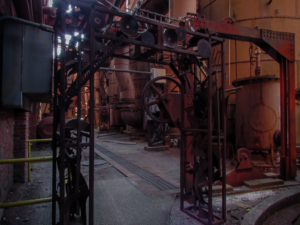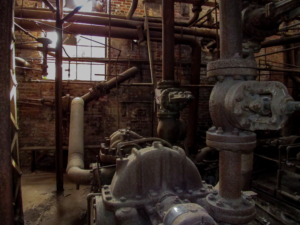The Sloss Furnaces National Historic Landmark
There are many historic sites across the state of Alabama. One of the most iconic is Sloss Furnaces in Birmingham.
“The history and formation of Birmingham is tied directly to the establishment of Sloss and the train and commercial infrastructure that supported it,” said DavidArias, executive director of Sloss Furnaces. “It wasn’t long before many related industries followed, creating the name Magic City because of the growth in those early years.”
Ty Malugani, the site’s educational coordinator, explained that Sloss is important to Birmingham because it represents the early history of the city, and it also highlights the working conditions and the experiences of work
ers during that time.
This is important due to how many citizens of Birmingham have ancestors who worked in the iron industry.

“They can physically see what brought them to Birmingham in the first place,” Malugani said, “which can be more powerful than just reading it out of a book.”
One product that is strongly associated with both Sloss Furnaces and Birmingham is pig iron, a crude form of iron produced in a blast furnace that is later remelted to make various types of products. Pig iron is produced using three ingredients: iron ore, limestone and coal.
Iron ore was commonly mined from Birmingham’s Red Mountain. It was purified by limestone mined from Jones Valley. Coal was mined from the Warrior Coal Field that lies beneath the Black Warrior River watershed.
More information about the Black Warrior River can be found here (link to class’ info on the rivers in AL).
The furnaces were active until 1970, and they completely shut down in 1971.
 “Sloss and many other companies in the steel industry closed in 1971 due to economic conditions, changes in the industry, but most importantly because of new environmental laws in 1970,” Arias elaborated. “It was not economically feasible to comply with the necessary environmental regulations in these old facilities.”
“Sloss and many other companies in the steel industry closed in 1971 due to economic conditions, changes in the industry, but most importantly because of new environmental laws in 1970,” Arias elaborated. “It was not economically feasible to comply with the necessary environmental regulations in these old facilities.”
Although the actual furnaces shut down and ceased to function decades ago, Sloss Furnaces still remains a popular site for tourists and Birmingham locals alike.
When arriving at Sloss Furnaces, visitors are given a brochure that takes them on a self-guided tour around the site. This tour details stories of the men who worked in the furnaces, the production of iron, the history of the furnaces and their environmental impact.
The historic site, however, is far more than just a museum for visitors to tour. Sloss is also a popular event venue.
 “The idea of using the site to host events, such as concerts and festivals, originated at the same time as the museum was built,” Malugani said. “They wanted Sloss Furnaces to not only be a place of learning and history, but also a community space where people can gather for events.”
“The idea of using the site to host events, such as concerts and festivals, originated at the same time as the museum was built,” Malugani said. “They wanted Sloss Furnaces to not only be a place of learning and history, but also a community space where people can gather for events.”
Sloss also has an expansive iron arts program. It includes four resident full-time artists, a visiting artist, a foundry manager and a director. This program hosts many activities, such as an eight-week summer apprenticeship, educational iron pours and more.
“We clearly have opportunities to hire and train metal artists, and we have nonprofit administration, education and leadership positions,” Arias said. “It’s a relatively small staff, but we indirectly impact many others through metal arts, events and educational opportunities.”
